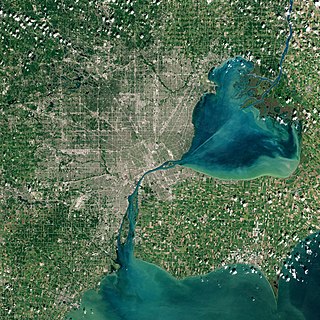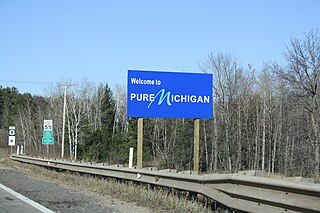
The Detroit metropolitan area, often referred to as Metro Detroit, is a major metropolitan area in the U.S. State of Michigan, consisting of the city of Detroit and its surrounding area. There are varied definitions of the area, including the official statistical areas designated by the Office of Management and Budget, a federal agency of the United States. Metro Detroit is known for its automotive heritage, arts, entertainment, popular music, food, cultural diversity and sports. The area includes a variety of natural landscapes, parks, and beaches, with a recreational coastline linking the Great Lakes. Metro Detroit also has one of the largest metropolitan economies in America with seventeen Fortune 500 companies.

The Chicago Hub Network is a collection of proposed fast conventional and high-speed rail lines in the Midwestern United States including 3,000 miles (5,000 km) of track. Since the 1990s, there have been multiple proposals to build a network from Chicago to destinations such as Milwaukee, Madison, Minneapolis, Indianapolis, Detroit, Kansas City, St. Louis, Cleveland, Cincinnati, and Louisville. In addition, the rail lines from the Chicago hub would connect through to cities in Canada. Eastern routes from Chicago would also blend into the Ohio Hub network. In addition to providing better connections between Midwestern cities, the projects are intended to reduce or eliminate the operating subsidies that American passenger train routes currently require.

Central Michigan, also called Mid Michigan, is a region in the Lower Peninsula of the U.S. state of Michigan. As its name implies, it is the middle area of the Lower Peninsula. Lower Michigan is said to resemble a mitten, and Mid Michigan corresponds roughly to the palm, encompassing the fertile rolling plains of the Michigan Basin. The region contains cities of moderate size, including Flint, Saginaw, and the state capital of Lansing.
Life Sciences Greenhouse of Central Pennsylvania (LSGPA) is a biotechnology initiative and non-profit organization based in Harrisburg, Pennsylvania. It was founded in 2001. It focuses on in the advancement of life sciences through technology to improve the healthcare and economic opportunities of Pennsylvanians.

The metropolitan area surrounding and including Detroit, Michigan, is a ten-county area with a population of over 5.9 million, a workforce of 2.6 million, and about 347,000 businesses. Detroit's six-county Metropolitan Statistical Area has a population of about 4.3 million, a workforce of about 2.1 million, and a gross metropolitan product of $200.9 billion. Detroit's urban area has a population of 3.9 million. A 2005 PricewaterhouseCoopers study estimated that Detroit's urban area had a gross domestic product of $203 billion.
Planning and development in Detroit since the late 20th century has attempted to enhance the economy and quality of life of Detroit, Michigan, United States. In 1970, the private group Detroit Renaissance began to facilitate development in the city. Its successor, Business Leaders for Michigan, has continued to facilitate development into the 21st century. Projects have included new commercial facilities, revitalization of neighborhoods, hospitality infrastructure, and improvements to recreational and public facilities, such as the QLine light rail project.

Pittsburgh Life Sciences Greenhouse (PLSG) is an investment firm based in the South Side neighborhood of Pittsburgh, Pennsylvania that provides resources and tools to entrepreneurial life sciences enterprises in Pittsburgh and western Pennsylvania in order to advance research and patient care.

The economy of Ohio nominally would be the 21st largest global economy behind Saudi Arabia and ahead of Argentina according to the 2017 International Monetary Fund GDP estimates. The state had a GDP of $656.19 billion in 3rd quarter of 2017, up from $517.1 billion in 2012, and up from $501.3 billion in 2011, according to the Bureau of Economic Analysis. In 2013, Ohio was ranked in the top ten states for best business climate by Site Selection magazine, based on a business-activity database. The state was edged out only by Texas and Nebraska for the 2013 Governor's Cup award from the magazine, based on business growth and economic development.

The Golden LEAF Foundation is a nonprofit corporation based in Rocky Mount, North Carolina in the United States, that was created in 1999 to receive half of the funds coming to North Carolina from the master settlement agreement with cigarette manufacturers. The foundation is now devoted to advancing the economic well being of North Carolinians and to transforming its economy. It works in partnership with local governments, educational institutions, economic development organizations and other public agencies, and nonprofits to achieve this goal.

Bio-1 is a consortium of partners founded in 2007 designed to identify and promote bioscience in the Central New Jersey area. It is the result of a $5 million grant made available by the Workforce Innovation in Regional Economic Development (WIRED) program.
China has seen double-digit growth in its biotechnology industry and has gone from being one of the slowest to one of the fastest nations in the adoption of new biotechnologies. The biotech sector is seen in China and internationally as a core area of national scientific and economic development. The main national biotech body in the country is the China National Center for Biotechnology Development. The CNCBD is an organization established on November 3, 1983, under the Ministry of Science and Technology with the approval of the State Council. CNCBD is the sole national center to coordinate and implement the national S&T program in Biotechnology and Health.

Pure Michigan began as an advertising campaign launched in 2008 by the state of Michigan, featuring the voice of actor and comedian Tim Allen, using the title song from The Cider House Rules as the background music in television commercials. The Pure Michigan campaign, which aims to market the state of Michigan as a travel and tourism destination, received state and international attention beginning in 2008 when Michigan Governor Jennifer Granholm approved $45 million in additional funding for the Pure Michigan campaign from the 21st Century Jobs Trust Fund. The unprecedented tourism fund amount for the state allowed the Pure Michigan campaign to be broadcast on a national level beginning in March 2009. Annual funding for fiscal 2014 was $29 million.
The Utah Science Technology and Research Initiative (USTAR) is a technology-based economic development agency funded by the state of Utah. The organization works to develop ideas and research into marketable products and successful companies through its competitive grant and entrepreneur support programs. USTAR facilitates the diversification of the state’s tech economy, increases private follow-on investment, and supports the creation of technology-based start-up firms, higher paying jobs and additional business activity leading to a statewide expansion of Utah’s tax base.
The official history of motion picture production in the U.S. state of Michigan dates back to the beginning of the Post–World War II baby boom. As of March 14, 2013, the Michigan Film Office website contains a list of 319, filmed in Michigan titles, beginning with This Time for Keeps, starring Esther Williams and in 1946, followed by Anatomy of a Murder, starring Jimmy Stewart and Lee Remick in 1959. Contemporary nationally known works filmed in the state include the drama Conviction (2010), starring Hilary Swank and Sam Rockwell, Kill the Irishman (2011), starring Val Kilmer and Christopher Walken, HBO's series Hung was filmed, and is set in, Detroit, and the Discovery Channel's Motor City Motors (2009), formerly Monster Garage (2002-2006). Originally slated for Minneapolis, Minnesota, Clint Eastwood's film Gran Torino (2008) was filmed in the Detroit area.
The Maryland Department of Commerce is a government agency in the state of Maryland in the United States. Although it was originally founded in 1884, the department came to be recognized as the Department of Commerce in 2015.

The Ohio bioscience sector strength was ranked #4 among USA states in 2008 by Business Facilities magazine.
Neogen Corporation is an international food safety company that provides test kits and relevant products to detect dangerous substances in food. The company was founded in 1982 and is based in Lansing, Michigan. The company serves a wide range of countries including Canada, United States, the United Kingdom, parts of Europe, Mexico and Brazil, India, and China, among others. As of 2016, the company has a market capitalization of $1.83 billion with an enterprise value of $1.57 billion. The company operates a product line of over 100 drug detection test kits worldwide for the detection of about 300 abused and therapeutic drugs in animal treatment. In 2009, it became a vendor of the Chinese government and has been engaged in researching China-specific food safety and plant health issues.

Henri A. Termeer was a Dutch biotechnology executive and entrepreneur who is considered a pioneer in corporate strategy in the biotechnology industry for his tenure as CEO at Genzyme. Termeer created a business model adopted by many others in the biotech industry by garnering steep prices— mainly from insurers and government payers— for therapies for rare genetic disorders known as orphan diseases that mainly affect children. Genzyme uses biological processes to manufacture drugs that are not easily copied by generic-drug makers. The drugs are also protected by orphan drug acts in various countries which provides extensive protection from competition and ensures coverage by publicly funded insurers. As CEO of Genzyme from 1981 to 2011, he developed corporate strategies for growth including optimizing institutional embeddedness nurturing vast networks of influential groups and clusters: doctors, private equity, patient-groups, insurance, healthcare umbrella organizations, state and local government, and alumni. Termeer was "connected to 311 board members in 17 different organizations across 20 different industries" He has the legacy of being the "longest-serving CEO in the biotechnology industry.

Greater Boston, primarily Boston and Cambridge, is home to more than 1,000 biotechnology companies, ranging from small start-ups to billion-dollar pharmaceutical companies. The many universities in the area give the region a large network of scientists.














